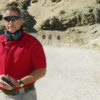Dry firing is an effective and inexpensive practice you can use to improve your shooting skills away from the range.
It’s an excellent way to train your eyes, body and trigger finger to pull the trigger smoothly without actually firing the weapon, helping you develop muscle memory through repetition.
Although dry firing does not involve ammunition, it is essential that you practice the four rules of gun safety:
- Always treat a gun as if it is loaded and perform a clearance check any time you pick one up.
- Never point your firearm at anything you’re not willing to destroy.
- Keep your finger off the trigger and outside the trigger guard until you’re ready to shoot.
- Always be sure of your target and know what’s beyond it.
When dry firing, your most important concern is safety. Clear your weapon, remove any and all ammunition from the area, and you know your target can stop a live bullet.
Look into dummy rounds or snap caps for dry fire practice. Ask your firearms retailer and experienced firearms trainer which will work best with your firearm.
1 – Practice using your everyday CCW, and conceal it as you normally do. Dry firing will help you develop the muscle memory needed to quickly and safely draw in a real world situation.
2 – Working on your trigger pull may not be the most exciting thing, but it is a valuable practice that will improve your marksmanship. Take it slow to develop your muscle memory.
3 – Visualize specific scenarios in which you may feel like it is necessary to draw your weapon.
4 – Use doorways, halls and obstructions to practice using your weapon in a variety of positions and stances. If there are other people present in the house, restrict your dry fire practice to a room, and make sure everyone is aware that you are practicing with your firearm.
5 – The privacy of your own home is a great place to practice different maneuvers that may be useful when faced with a threat. Again, building muscle memory is important to train your mind and body to react appropriately. Start slowly and gradually increase your speed once you’ve mastered the movement.
Keep your dry fire training sessions short, not more than 15 minutes. This should be a time of intense, uninterrupted concentration.


